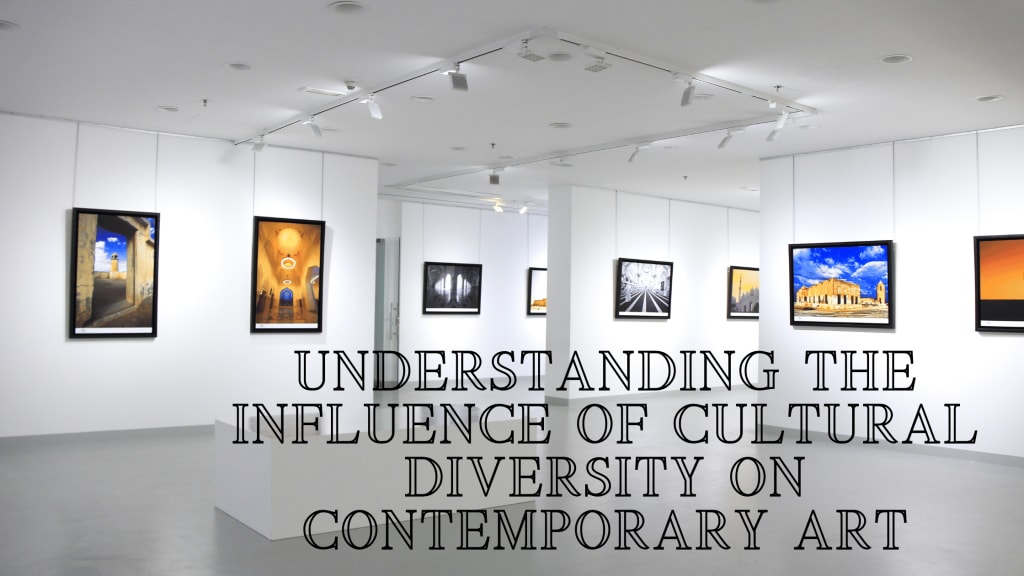Variety is the Spice of Life
Understanding the Influence of Cultural Diversity On Contemporary Art

Cultural diversity is an incredibly important aspect of creating a stronger and better world. It allows individuals to communicate more creatively, helping to overcome any language barriers through the universal language of human creativity. Art, on the other hand, helps in this cultural expression that develops pride in one's heritage while simultaneously reducing cultural boundaries. Cultural diversity, however, in contemporary art is not limited to stylistic influences or artistic rules. Modern artists are increasingly using their work to shed light on and draw societal attention to broader issues - particularly issues affecting their own culture or heritage - thereby bridging the gaps between people of different backgrounds and fostering a sense of empathy and connection. This shift towards celebrating cultural diversity in the arts, with artists from around the world infusing their work with unique perspectives, narratives, and traditions, is enriching the artistic landscape and fostering inclusivity and representation in the arts.
Embracing Cultural Diversity
Contemporary art has evolved into a global phenomenon by transcending geographical boundaries, sharing ideas with the world, and embracing cultural diversity. Artists draw inspiration from their heritage, ancestry, and lived experiences, incorporating elements of language, symbolism, and iconography into their work. This infusion of cultural diversity adds depth, complexity, and resonance to contemporary art, challenging viewers to engage with unfamiliar perspectives and narratives.
Notable Artists and Artworks
Numerous artists have made significant contributions to celebrating cultural diversity in contemporary art. Yayoi Kusama, known for her immersive installations and polka dot motifs, explores themes of identity, obsession, and infinity, drawing from her Japanese heritage. Kara Walker's provocative silhouette artworks confront issues of race, gender, and power, challenging viewers to confront uncomfortable truths about America's history of slavery and racial inequality, as well as its intersection with gender inequality.
Ai Weiwei, a prominent Chinese artist and activist, uses his art to critique authoritarianism, censorship, and human rights abuses in China. His installations, sculptures, and social media activism serve as powerful vehicles for raising awareness and advocating for change. Another notable artist, Kehinde Wiley, subverts traditional portraiture by depicting African American subjects in poses and settings inspired by Old Master paintings, challenging stereotypes and reclaiming narratives of representation. Wherever you look in the art world, there are countless examples of individuals whose artistic style is intentionally inclusive and has been developed through their cultural lens.
Importance of Inclusivity and Representation
Fostering inclusivity and representation in the arts is essential for creating a more equitable and diverse cultural landscape. By amplifying marginalized voices, challenging dominant narratives, and celebrating diverse perspectives, the arts become a powerful tool for social change and cultural empowerment. Inclusive representation reflects the richness and complexity of human experience and fosters empathy, understanding, and connection across cultural divides.
Conclusion
Cultural diversity's influence on art is undeniable, and its influence on contemporary art, in particular, is incredibly striking. It shapes the artistic landscape and challenges conventional notions of identity, representation, and artistic expression. Through the work of notable artists, including Yayoi Kusama, Kara Walker, Ai Weiwei, and Kehinde Wiley, we see the power of art to transcend borders, confront injustice, and celebrate the diversity of human experience all around the globe.
As we continue to navigate an increasingly interconnected and diverse world, fostering inclusivity and representation in the arts becomes more important than ever. By amplifying diverse voices, challenging dominant narratives, and embracing cultural differences, we can create a more equitable and inclusive cultural landscape that reflects the richness and complexity of our shared humanity. In doing so, we enrich the artistic experience and contribute to a more just, empathetic, and interconnected society where we gain a deeper appreciation for each others' experiences.
About the Creator
Janam Anand
Janam Anand is a seasoned advertising professional specializing in retail media and advertising. Janam loves music, art, and culture. Visit JanamAnand.net.
Enjoyed the story? Support the Creator.
Subscribe for free to receive all their stories in your feed. You could also pledge your support or give them a one-off tip, letting them know you appreciate their work.






Comments (1)
Nice writing , keep it up